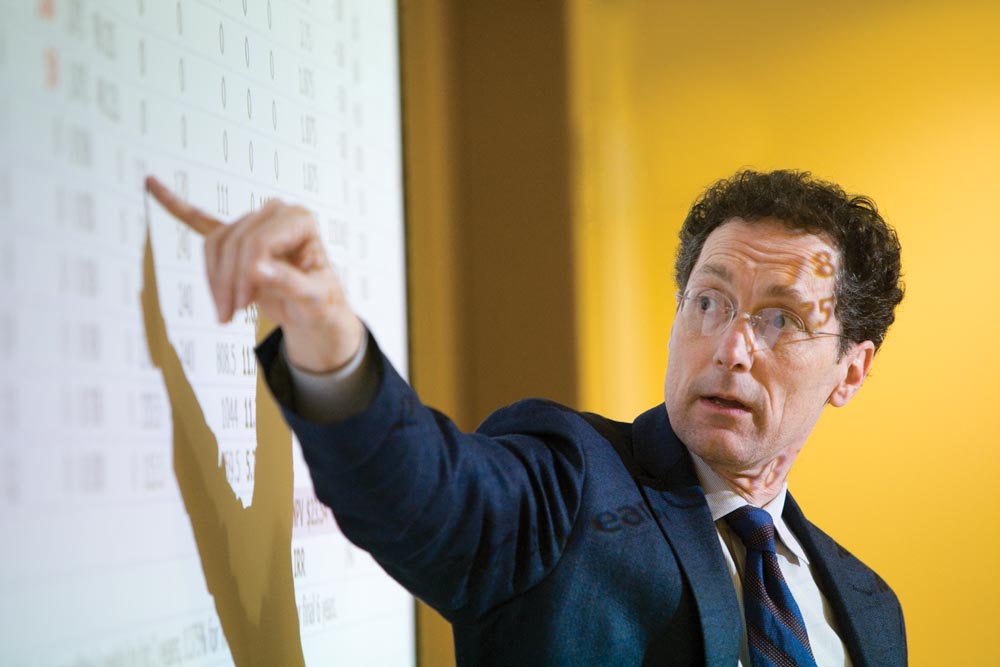The University and the Economy: Reality Checks
Amid financial turmoil, class bridges theory and practice
In quantitative finance courses like Com 478, students live in the theoretical world.
They learn the mathematical theories that underpin the pricing and structure of the various sophisticated financial instruments used by banks and hedge funds. They have to get their heads around the complexities of stochastic calculus, probability distributions, linear algebra and Monte Carlo methods to model derivative trades. Not surprisingly, those who work in this field (“quants”) are considered the rocket scientists of the financial world.
It’s the kind of highly abstract, mathematically intensive material that leads to grumbling among commerce students about just how relevant it all is.
“In the past, there’s definitely been some pushback among students—not so much in recent years, because a lot of them get jobs in structured finance—but still a pushback about this stuff being esoteric,” says McIntire professor William J. Wilhelm Jr., an investment banking specialist who has been teaching this material since 1988.
“But this past fall, this was first order. It was right in your face.”
Just as the fall 2008 semester was getting under way, the U.S. government seized the nation’s two largest mortgage finance companies, Fannie Mae and Freddie Mac. Days later, on Sept. 14, the top news was that Lehman Brothers was headed into bankruptcy; Merrill Lynch had agreed to be bought by Bank of America; and AIG was asking the Federal Reserve for a $40 billion lifeline. The financial turmoil deepened daily. But for the fourth-year students in Com 478—Advanced Corporate Finance—the timing couldn’t have been better.

“For a while, I essentially started class by saying, ‘OK, what do you think about this?’” says Wilhelm, finding fodder in the latest headlines. The events unfolding “played right into the wheelhouse” of what they were studying about structured finance, he adds, specifically the realm of mortgage- and asset-backed securities, the source of so many problems in the marketplace.
“There were stunning things going on in the financial markets. It’s not even the kind of thing that a nonspecialist can appreciate,” Wilhelm says, “because a lot of it was down at the level of the plumbing. We’re talking about subtle issues, things in the far corners of the credit market.”
As economic events unfolded throughout the semester and laid bare the mechanics of various financial operations, students discovered that quantitative finance could be, well, dynamic. It wasn’t just a theoretical exercise anymore.
“It was nice in class to see the real-world applications of what we were studying,” says Patrick McKeegan (Com ’09). “We spent a fair amount of time on risk assessment, how banks go about assessing risk, and there were all these direct examples. It was really easy to tie things to fundamental concepts.
“At the same time,” he adds, “it was confusing because you had all sorts of experts with competing theories.”
In the past five years, the Commerce School has ramped up the quantitative side of its curriculum. The shape of the industry is changing, and it’s become increasingly important for students to have an understanding of the technical side of corporate business—skills that many in senior management at failing institutions may have lacked, Wilhelm observes.
On Sept. 21, the Federal Reserve announced that Goldman Sachs and Morgan Stanley, the last big independent investment banks on Wall Street, would become bank holding companies subject to greater regulation. On Oct. 10, the Dow Jones posted its worst week on record. On Oct. 13, the Treasury announced plans to inject $250 billion into banks in exchange for equity.
“Students were certainly more motivated by all these stories in the press,” says Wilhelm, who typically uses case studies in his lesson plans. As difficult as the material was, students put in the extra hours, dug a little deeper and ultimately outperformed previous classes. “They certainly had a lot of questions.”
The larger question of how such a financial catastrophe can be averted is harder to answer.
“Will we learn from the latest smashup?” Wilhelm asks. “Yes, and the process, both in academia and among practitioners, is moving forward at a rapid pace. Does that mean we’ll never have another smashup? Almost certainly not. Were that the case, it would surely come at the cost of many foregone benefits achievable only with a willingness and ability to take risks.”
Special Report: The University and the Economy
This article appeared as part of a larger section on how the recent economic turmoil is affecting UVA and its alumni. Read more:
- On the Front Lines
Alumni and faculty experts share their perspectives on how we got into this situation—and how to get out of it. - Time and Money
A timeline tracks how the University has weathered economic ups and downs throughout the years. - In the Classroom
As economic events unfolded, some professors threw away their syllabi and kept pace with breaking news. - Students Speak
Learn how some students are coping with the economy—with video. - Your Financial Health
Assess your personal finances with a quiz from McIntire professor Karin Bonding. - A Different World
A first-person perspective on how Circuit City’s collapse altered the career path of one alumnus.